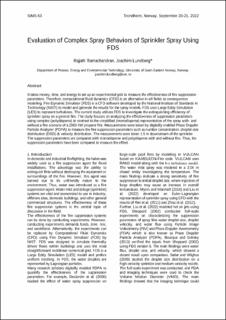Evaluation of Complex Spray Behaviors of Sprinkler Spray Using FDS
Peer reviewed, Journal article
Published version
Permanent lenke
https://hdl.handle.net/11250/3036297Utgivelsesdato
2022Metadata
Vis full innførselSamlinger
Originalversjon
Ramachandran, R., & Lundberg, J. (2022, 20.-21. september). Evaluation of Complex Spray Behaviors of Sprinkler Spray Using FDS. Proceedings of the 63rd International Conference of Scandinavian Simulation Society, SIMS 2022, Trondheim. https://doi.org/10.3384/ecp192025Sammendrag
It takes money, time, and energy to set up an experimental grid to measure the effectiveness of fire suppression parameters. Therefore, computational fluid dynamics (CFD) is an alternative in all fields as consequences modeling. Fire Dynamic Simulator (FDS) is a CFD software developed by the National Institute of Standards in Technology (NIST) to model and generate the results for the spray models. FDS uses Large Eddy Simulation (LES) to represent turbulence. The current study utilizes FDS to investigate the extinguishing efficiency of sprinkler spray on e general fire. The study focuses on analyzing the effectiveness of suppression parameters using complex (polydisperse) in contrast to the simplified (monodisperse) representation of the spray with- and without a fire scenario of a 2560 kW propane fire. Measurements were taken by digitally enabled Phase Doppler Particle Analyzer (PDPA) to measure the fire suppression parameters such as number concentration, droplet size distribution (DSD) & velocity distribution. The measurements were taken 1.5 m downstream of the sprinkler. The suppression parameters are compared with monodisperse and polydisperse with and without fire. Thus, the suppression parameters have been compared to measure the effect.

